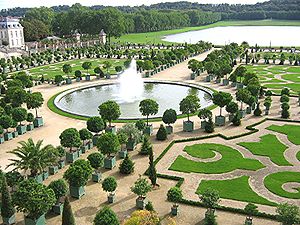
Versailles Orangerie
Encyclopedia
The Versailles Orangerie
(French: L′Orangerie du Château de Versailles) was built by Jules Hardouin-Mansart between 1684 and 1686, that is to say, before work on the castle had even begun. It is an example of many such prestigious extensions of grand gardens in Europe designed both to shelter tender plants and impress visitors. In the winter, the Versailles Orangerie houses more than a thousand trees in boxes. Most of them are orange trees. From May to October, they are put outdoors in the Parterre Bas.
 The sweet orange (Citrus aurantium) was introduced to Europe by the fifteenth to sixteenth centuries. At first, they were an expensive food item. Medieval cookbooks tell exactly how many orange slices a visiting dignitary was entitled to. Citrus soon became the fashion of the nobility and rich merchants. By the sixteenth century, sweet oranges had become well-established and had assumed commercial importance in Europe.
The sweet orange (Citrus aurantium) was introduced to Europe by the fifteenth to sixteenth centuries. At first, they were an expensive food item. Medieval cookbooks tell exactly how many orange slices a visiting dignitary was entitled to. Citrus soon became the fashion of the nobility and rich merchants. By the sixteenth century, sweet oranges had become well-established and had assumed commercial importance in Europe.
In France, the first orangerie had been built and stocked by Charles VIII of France
at the Château of Amboise
There is general agreement that the arrival of the sweet orange to Europe was linked with the activities of the Portuguese during the fifteenth century, and particularly the travels of circumnavigation to the east carried out by Vasco de Gama. Although the Romans
had been acquainted with lemons and probably sour oranges
as well as citrons, the different types - sour oranges, lemon
s and sweet oranges
- reached Europe centuries apart. By withholding water and nutrients, and by using pruning techniques, French gardeners were able to make citrus trees bloom during the entire year, to the delight of Louis XIV. Citrus motifs formed themes in sculpture, mosaics, embroidery, weaving, paintings, poems, and songs, throughout history and orange blossoms remain prized as floral ornaments at weddings.
. This separates it from the Swiss Pond.
Orangery
An orangery was a building in the grounds of fashionable residences from the 17th to the 19th centuries and given a classicising architectural form. The orangery was similar to a greenhouse or conservatory...
(French: L′Orangerie du Château de Versailles) was built by Jules Hardouin-Mansart between 1684 and 1686, that is to say, before work on the castle had even begun. It is an example of many such prestigious extensions of grand gardens in Europe designed both to shelter tender plants and impress visitors. In the winter, the Versailles Orangerie houses more than a thousand trees in boxes. Most of them are orange trees. From May to October, they are put outdoors in the Parterre Bas.
The allure of citrus

In France, the first orangerie had been built and stocked by Charles VIII of France
Charles VIII of France
Charles VIII, called the Affable, , was King of France from 1483 to his death in 1498. Charles was a member of the House of Valois...
at the Château of Amboise
Château d'Amboise
The royal Château at Amboise is a château located in Amboise, in the Indre-et-Loire département of the Loire Valley in France.-Origins and royal residence:...
There is general agreement that the arrival of the sweet orange to Europe was linked with the activities of the Portuguese during the fifteenth century, and particularly the travels of circumnavigation to the east carried out by Vasco de Gama. Although the Romans
Ancient Rome
Ancient Rome was a thriving civilization that grew on the Italian Peninsula as early as the 8th century BC. Located along the Mediterranean Sea and centered on the city of Rome, it expanded to one of the largest empires in the ancient world....
had been acquainted with lemons and probably sour oranges
Bitter orange
The name "bitter orange", also known as Seville orange, sour orange, bigarade orange, and marmalade orange, refers to a citrus tree and its fruit. Many varieties of bitter orange are used for their essential oil, which is used in perfume and as a flavoring...
as well as citrons, the different types - sour oranges, lemon
Lemon
The lemon is both a small evergreen tree native to Asia, and the tree's ellipsoidal yellow fruit. The fruit is used for culinary and non-culinary purposes throughout the world – primarily for its juice, though the pulp and rind are also used, mainly in cooking and baking...
s and sweet oranges
Orange (fruit)
An orange—specifically, the sweet orange—is the citrus Citrus × sinensis and its fruit. It is the most commonly grown tree fruit in the world....
- reached Europe centuries apart. By withholding water and nutrients, and by using pruning techniques, French gardeners were able to make citrus trees bloom during the entire year, to the delight of Louis XIV. Citrus motifs formed themes in sculpture, mosaics, embroidery, weaving, paintings, poems, and songs, throughout history and orange blossoms remain prized as floral ornaments at weddings.
Location in the garden
The Versailles Orangerie is under the flowerbed known as "parterre du midi". Its central gallery is 155 metres in length, and its frontage is directed towards the south. The “Parterre Bas” is bordered on its south side by a balustrade overlooking the Saint-Cyr-l'ÉcoleSaint-Cyr-l'École
Saint-Cyr-l'École is a commune in the western suburbs of Paris, France. It is located from the center of Paris.It used to host the training school for officers of the French army, the École Spéciale Militaire de Saint-Cyr , which was relocated to Coëtquidan in 1945.The old buildings of the ESM are...
. This separates it from the Swiss Pond.

